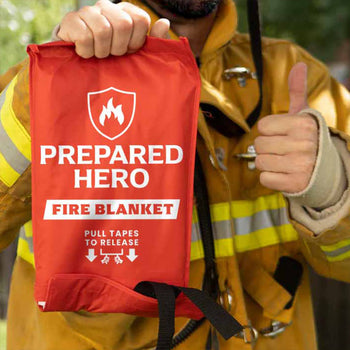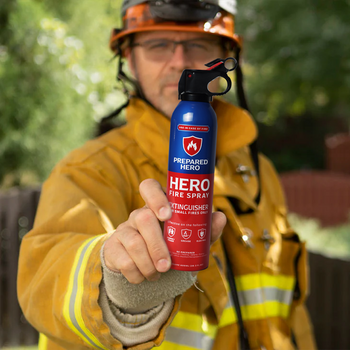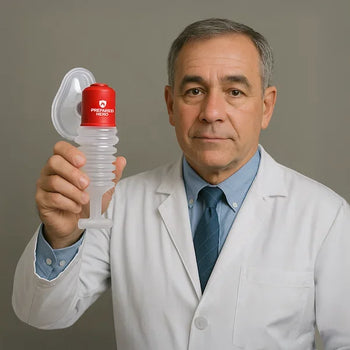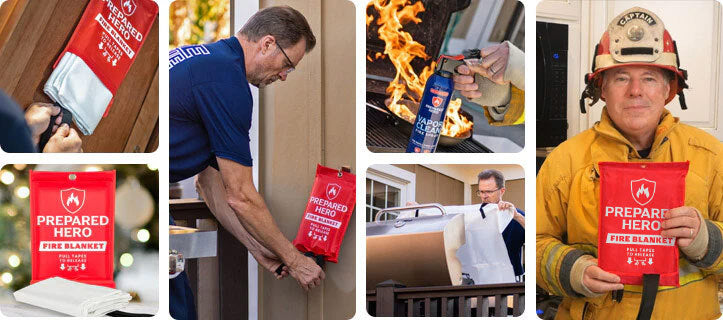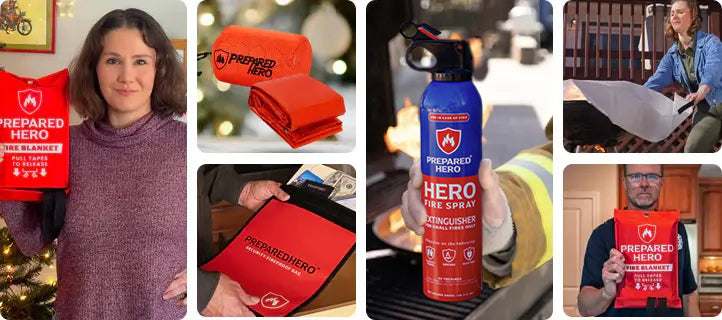Where you put your smoke detectors matters just as much as installing them. Proper placement makes sure they can detect...
Dryers are lifesavers when it comes to laundry. They save us time and keep our clothes fresh without the hassle of hang-drying. But have you ever wondered how hot a dryer gets?
While heat is key to drying clothes, too much can cause problems, including damaged clothes and dryer fires. If you're curious about the right temperature for your dryer or why it's too hot, you’re in the right place. Find out how a dryer gets and the top signs of overheating below.
How Does a Dryer Work?

A dryer removes moisture from clothes by heating air and blowing it through a spinning drum. The drum turns so clothes don’t clump, and small fins inside help separate them.
Air first enters the dryer and passes over a heating element, which warms it up. This hot air moves through the drum and absorbs moisture from the clothes. The humid air then exits through a vent, so fresh, dry air can enter. Most dryers cool down at the end of the cycle. This helps prevent wrinkles and makes clothes easier to handle.
There are two main types of dryers: timed dryers that run for a set period and sensor dryers that detect moisture levels and stop when clothes are dry. This saves energy and prevents overdrying.
Regular maintenance helps your dryer work well. So clean the lint trap, check the exhaust vent, and don’t overload the drum. Remember, a well-maintained dryer dries clothes faster, saves energy, and lasts longer.
Do Dryers Kill Germs?

A dryer can help reduce germs but doesn’t kill them all. Most germs start dying at 113°F, but you need at least 140°F to fully disinfect clothes. Some home dryers only reach about 135°F, so they don’t always get hot enough.
If you want to get rid of as many germs as possible, always wash your clothes with detergent before drying them. Hot water and disinfectant detergents help kill more bacteria and viruses. You can also use your washer’s "sanitize" cycle for extra heat.
If you don’t have a dryer or can’t use high heat, hang clothes outside on a sunny day. UV rays can help kill some germs, though not all. More importantly, focus on washing your hands, avoiding germy surfaces, and keeping your home clean. These habits do more to keep you healthy than relying on a dryer alone.
How Hot Does a Dryer Get?

Dryers heat up to remove moisture from clothes, but the temperature varies depending on the setting. Most home dryers range from 120°F to 160°F, while some commercial dryers can reach 176°F. Here’s a breakdown of common dryer heat settings:
Low Heat
Also called the delicate cycle, the low heat setting is usually at 105°F to 115°F. It takes longer to dry clothes. However, it helps prevent delicate fabrics like silk, lace, and rayon from shrinking and getting damaged. This setting is ideal for lightweight clothing, activewear, and heat-sensitive fabrics.
Medium Heat
Medium heat is not available on all dryers. But when it is, it usually ranges from 125°F to 135°F. It’s a great middle-ground for synthetic fabrics, polyester blends, and slightly thicker materials. It dries faster than low heat but is still gentle enough to prevent shrinkage and damage.
High Heat
Also labeled regular or heavy-duty, the high heat setting reaches 130°F to 160°F. This setting dries clothes the fastest. It’s ideal for towels, jeans, and heavy cotton fabrics. However, it can shrink or damage delicate items if used incorrectly.
No Heat
The no-heat or air fluff cycle doesn’t use heat at all. Instead, it blows room-temperature air to help remove dust, pet hair, or wrinkles from already-dry clothes.
Note: These temperatures are just average. The temperature at which your clothes dry depends on the make and model of your machine. Read your user’s manual for more information about your specific model.
How Hot Does a Dryer Vent Get?

A dryer vent usually gets between 120°F and 160°F, but should never go over 200°F. When your dryer works properly, hot air moves through the vent to remove moisture from your clothes. As the air travels outside, it cools down. There’s usually a problem if the vent is too hot. Here are the factors affecting your dryer vent’s temperature:
- Type of Dryer: Gas dryers tend to get hotter than electric ones, so they might push out hotter air.
- Vent Length and Shape: A long or twisted vent makes it harder for air to escape, which raises the temperature.
- Ventilation System: The vent can get hotter than normal if it’s not installed properly or your home lacks airflow.
- Lint Buildup: Lint can clog the vent, trap heat, and make your dryer work harder. It’s also a fire hazard.
Regularly clean your dryer vent and check for blockages to keep everything safe. A properly working dryer vent keeps your home safe and dries your clothes efficiently.
Can a Dryer Overheat?

Yes, a dryer can overheat, and it’s usually a sign that something is wrong. When a dryer gets too hot, it can damage clothes, make the machine less efficient, and cause a Class C or electrical fire.
One common cause is lint buildup. Lint can clog the vent or filter, blocking airflow. When hot air can’t escape properly, the dryer works harder and overheats. Another issue is a blocked or twisted vent hose. Heat gets trapped inside if the air has trouble flowing out. A faulty thermostat or heating element can also cause overheating. If these parts aren’t working right, the dryer may get hotter than it should.
5 Signs Your Dryer is Overheating

It’s important to catch the problem early if your dryer is overheating. Here are some signs to watch for:
1. Clothes Feel Extremely Hot
It’s normal for clothes to be warm after drying. But your dryer might be overheating if they’re too hot to touch. This can also cause your clothes to wear out faster, and is a fire risk.
2. Burning Smell
A hot, burning odor is another red flag. Lint buildup in the vent or faulty dryer parts could be to blame. If you smell something burning, it’s best to stop the dryer immediately and check for issues. Find out what an electrical fire smells like here.
3. The Dryer Feels Hotter Than Usual
Is the outside of your dryer unusually hot to the touch? This probably means heat is trapped inside. A blocked vent or other internal problems are likely the culprit.
4. Takes Longer to Dry Clothes
An overheating dryer struggles to do its job efficiently. It has to work harder to dry your clothes, which could result in longer drying times. If this happens, it's time to check for issues.
5. Shuts Off Mid-Cycle
Some dryers have built-in safety features that automatically shut them down if they get too hot. If this happens, have the dryer checked by a technician to prevent safety risks or damage.
Why Do Dryers Get Too Hot?

A dryer that runs too hot isn’t just a nuisance—it’s also a fire hazard. Here are the most common reasons dryers overheat and how to fix them.
1. Blower Wheel Issues
Lint, small socks, or dryer sheets can get stuck in the blower wheel, which reduces airflow and makes the dryer overheat. A worn-out blower wheel may also wobble, slow down airflow, and cause overheating.
How to Fix: Unplug the dryer before opening it up. Then, check the blower wheel and remove any obstructions. The wheel needs to be replaced if it wobbles. Call a technician to replace the wheel.
2. Faulty Thermostat or Timer
A broken thermostat can’t regulate heat properly, while a faulty timer may keep the dryer running too long.
How to Fix: Call a professional to repair or replace the thermostat or timer. This can’t be DIY-ed.
3. Wrong Heat Settings
Using high heat for all fabrics can lead to overheating. Delicate fabrics need lower temperatures.
How to Fix: Check your dryer manual to match the settings with fabric types.
4. Blocked Exhaust Vent
Lint buildup in the vent restricts airflow, causing heat to build up inside the dryer.
How to Fix: Clean your dryer vent regularly to prevent blockages.
5. Clogged Lint Screen
A full lint trap reduces airflow. This makes the dryer work harder and overheat.
How to Fix: Clean the lint screen after every cycle.
6. Defective Heating Element
The dryer won’t stop generating heat as long as the defective heating element is there.
How to Fix: Have a professional inspect and replace the heating element if needed.
7. Worn Drum Seals
Damaged drum seals let in excess heat and raise internal temperatures.
How to Fix: Replacing drum seals is tricky, so get a professional to do it.
8. Kinked Exhaust Hose
A bent or crushed exhaust hose restricts airflow, which leads to overheating.
How to Fix: Check the exhaust hose if you can. Otherwise, call a technician. Make sure the exhaust hose is straight and unblocked.
7 Dryer Safety Tips

Keeping your dryer in good shape isn’t just about efficiency. It’s also about your loved ones’ safety. Here’s how to prevent dryer fires and keep your home safe:
1. Have a Fire Prevention Kit
A fire prevention kit includes a fire blanket, fire spray, fire protection gloves, and fire extinguisher. You should also have photoelectric smoke detectors, ionization smoke detectors, and fire sprinklers around. Having them helps you act fast during a fire emergency.
2. Clean the Lint Filter After Every Load
Lint buildup is the top cause of dryer fires. Always clean the lint filter before or after each use. Remove lint around the drum as well.
3. Keep the Dryer Vent Clear
A blocked vent can cause overheating. Check the exhaust vent regularly to make sure it’s not clogged with lint, and clean it at least once a year.
4. Don’t Overload the Dryer
Stuffing too many clothes in the dryer makes it harder for air to circulate, which can lead to overheating. Follow the manufacturer’s load recommendations.
5. Use the Right Plug and Outlet
Dryers need to be properly grounded and plugged into the correct outlet. Never use an adapter or extension cord because this increases the risk of electrical fires.
6. Never Leave the Dryer Running Unattended
Turn off the dryer before leaving home or going to bed. If something goes wrong, you want to catch it early.
7. Keep the Area Around the Dryer Clear
Store flammable items like cleaning supplies, boxes, and clothes away from the dryer. A clear space reduces fire risks and makes room for proper airflow.
Will a Dryer Shut Off if It Gets Too Hot?

Yes, many dryers will shut off automatically if they get too hot. This is a safety feature that prevents fires and other damages. When a dryer overheats, the thermal fuse or heat sensors can stop the machine mid-cycle. This helps avoid potential issues like burnt clothes, damage to the dryer, and dryer fires. If your dryer shuts off unexpectedly, it’s a sign that something might be wrong.
How Hot Is Too Hot to Dry Clothes?

Anything higher than 160°F is too hot to dry clothes. Your clothes can shrink, fade, or get damaged when they get too hot. Plus, overheating can stress out your dryer and lead to bigger problems like damage and fire. If you notice your dryer getting unusually hot or taking longer than normal to dry clothes, check the vent, clean the lint filter, or inspect other parts.
How Hot Does a Dryer Get On Sanitize?

A dryer goes over 150°F to sanitize clothes. This high heat helps kill germs, bacteria, and allergens on your clothes. It’s great for bedding, towels, or clothes that need extra sanitizing. However, this intense heat isn’t meant for delicate fabrics. Always check your dryer’s manual for specific recommendations to make sure you’re using the sanitizing cycle properly.
Conclusion
Dryers work hard to get clothes dry, but can lead to fires and damage when overheated. Knowing how hot your dryer gets and when it gets too hot keeps your clothes and loved ones safe. Regular maintenance, like cleaning the lint trap and checking the exhaust vent, goes a long way in preventing such problems. Do you want reliable, easy-to-use, and affordable tools to put out dryer fires before they spread? Check out Prepared Hero’s fire prevention tools here, and get up to 51% off on certain items. Stay prepared, hero!


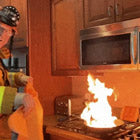 Fire
Fire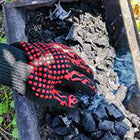 Safety
Safety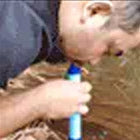 Survival
Survival Protection
Protection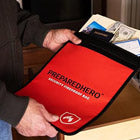 New
New
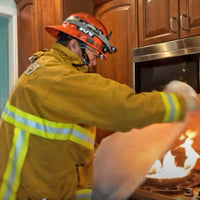 Fire
Fire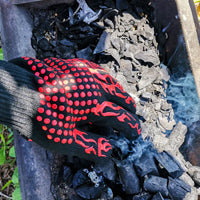 Safety
Safety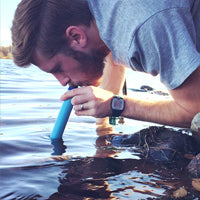 Survival
Survival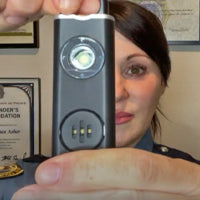 Protection
Protection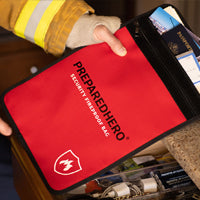 New
New
